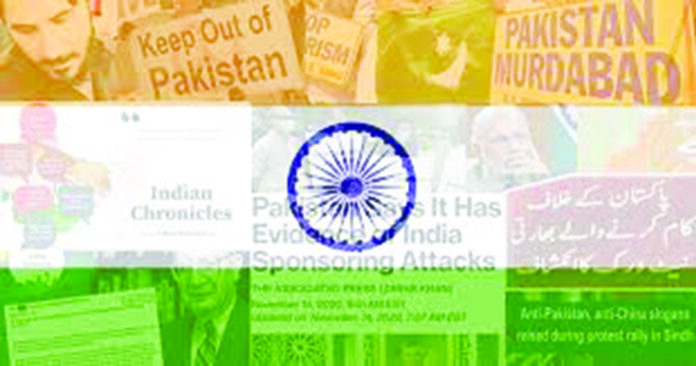In the digital age, with the integration of artificial intelligence (AI) and where information travels at the speed of light, social media has become a battleground for narratives, ideologies, and geopolitical manoeuvring.
This is no more evident than in the frosty relations between India and Pakistan. The virtual war rages on, with a special focus on India, deploying an arsenal of misinformation, disinformation, and propaganda to shape public opinion and influence global discourse. As Joseph Goebbels, the Nazi Minister of Propaganda stated, “If you tell a lie big enough and keep repeating it, people will eventually come to believe it.”
This seems to be the motivation of Hindutwa propagandists as disinformation thrives on ambiguity and emotion. India leverages historical grievances, cultural stereotypes, and fear to create a toxic brew. False narratives about Pakistan’s nuclear programme, alleged state-sponsored terrorism, and religious extremism have found fertile ground online, shaping public perception and policy decisions beyond just the realm of trolls and bots.
India has mastered the art of using social media as a weapon. Its campaigns against Pakistan are carefully orchestrated, targeting not only domestic audiences but also the international community. From Twitter storms to coordinated Facebook posts, India’s propaganda machine churns out narratives that demonize Pakistan, question its legitimacy, and amplify existing fault lines. For instance, an investigative report compiled by Disinfo Lab from the European Union, exposed a New Delhi-based investment firm, the Srivastava Group, for arranging an extensive disinformation campaign and influence operations. According to the report, since 2005, these campaigns have specifically targeted EU politicians and institutions to portray Pakistan and China negatively.
The investigation also uncovered a connection between 10 UN-accredited NGOs and the Srivastava Group, based in Brussels and Geneva. The report includes evidence of 10 NGOs accredited with the UN being directly linked to the Srivastava Group, operating in Brussels and Geneva, and organizing trips for European Parliament members to Indian-occupied Kashmir, falsely representing them as sanctioned by Parliament. The European non-profit organization, EU Disinfo Lab, has also proven the Indian agenda of spreading disinformation against Pakistan and China, particularly through the popular Indian news agency, Asia News International (ANI).
Furthermore, India’s main news agency, ANI, predominantly features articles from over 500 fake news sites spread across 96 countries associated with the Srivastava Group. While India’s government denies any involvement, these revelations accentuate the persistent distrust between the two nuclear powers, India and Pakistan, despite their shared history and geographic proximity. The report highlights ANI’s repeated use of false sources, including a defunct think tank called POREG, journalists, bloggers, and fictional geopolitical analysts. These fabricated narratives aimed at smearing India’s geopolitical adversaries make it impossible to trust Indian claims of noninvolvement in the spread of such misinformation.
The rapid expansion of internet access has enabled the proliferation of misinformation by Indian users. It was observed during the covid-19 epidemic that internet users in India escalated from 422.2 million in 2017 to 845.7 million in 2021, amplifying the spread of misinformation. This trend was observed to be exacerbated by the covid-19 pandemic, as the affordability of low-budget mobile phones and internet plans led to an even greater influx of users. With the increased number of users, the chances of more misinformation increased, as social media sites and apps did not include any fact checkers in them. As a result, the public shared all the misinformed posts in a great number.
Another example of the influx of misinformation resulting in tensions between the religious minorities within India during covid-19. The Hindus blamed Muslims, propagated and linked this misinformation blaming the Muslims for the spread of covid-19, resulting in economic hardship for Muslim vendors, illustrating the profound impact of misinformation on minority communities. The consequences of this misinformation warfare were far-reaching. It fueled mistrust, escalated tensions, and perpetuated a cycle of hostility between the two religions, Hindus and Muslims.
Moreover, the BJP Government in India has used this manipulation of information to sway public opinion, a stark departure from Narendra Modi’s initial slogan of “Sabka Saath Sabka Vikaas (Everyone’s support, everyone’s development).” As Modi consolidated power, the discourse shifted, fostering extremism and stoking anti-Muslim sentiments. The biggest tool of Modi in this war is the manipulation and spread of disinformation through social media apps explicitly overseen by the Modi-led media wings. Resultantly, any misinformation or disinformation spread by Indian users through apps like WhatsApp remained unchecked. On the contrary, any post or source of disinformation against the BJP is immediately removed from the app proving the fact that the government itself is involved in the evil media game.
The recent election in India highlighted the widespread dissemination of misinformation aimed at manipulating the outcome. Bollywood stars rarely engage in political discussions, so when videos surfaced showing two celebrities criticizing Indian Prime Minister Narendra Modi and endorsing his main opposition, the Congress party, they quickly went viral.
However, these clips featuring A-list actors Aamir Khan and Ranveer Singh were fake, AI-generated videos, representing yet another instance of false or misleading claims circulating online to influence India’s election. Additionally, various claims have circulated online in India, misrepresenting details about voting procedures, alleging without evidence that the election would be rigged, and inciting violence against India’s Muslim population. Researchers monitoring misinformation and hate speech in India argue that the poor enforcement of tech companies’ policies has created ideal conditions for harmful content to distort public opinion, incite violence, and leave millions of voters uncertain about what to believe.
Promoting a culture of critical thinking by encouraging people to verify information before sharing and providing user-friendly fact-checking tools and resources, like browser add-ons and mobile apps, can make a significant impact. Finally, educating the public on how to critically assess information, recognize biases, and identify reliable sources, while collaborating with government, NGOs, media, and technology sector partners, will enhance the message and optimize resource utilization.
The spread of misinformation can trigger real-world actions, affecting diplomatic relations, security dynamics, and even the delicate balance of nuclear deterrence. As long as social media exists, so will the battle of bytes.
India must recognize that its virtual skirmishes have real-world consequences. A multifaceted approach utilising various communication channels is essential to address the dangers of deception and emphasize the importance of evidence-based information. This includes leveraging social media, traditional media, and community engagement to broaden the reach towards factual data. Partnering with respected community figures, influencers, and experts can help strengthen the message and build trust.
Creating compelling and educational content, based on truth and facts, such as infographics, videos, and podcasts, will engage interest and encourage sharing. It is crucial to empower the public to identify and report misinformation, fostering a sense of accountability and ownership. Integrating media literacy and critical thinking skills into school curricula and community initiatives, along with organizing events, rallies, and educational campaigns, will increase awareness and spread evidence-based information. Using data analytics to monitor misinformation patterns, identify vulnerable audiences, and tailor messaging accordingly is also vital.
Promoting a culture of critical thinking by encouraging people to verify information before sharing and providing user-friendly fact-checking tools and resources, like browser add-ons and mobile apps, can make a significant impact. Finally, educating the public on how to critically assess information, recognize biases, and identify reliable sources, while collaborating with government, NGOs, media, and technology sector partners, will enhance the message and optimize resource utilization.























